September 2021
How Cubas Heroic Wasp Network
Stung U.S.-Backed Counterrevolutionaries
By Alice
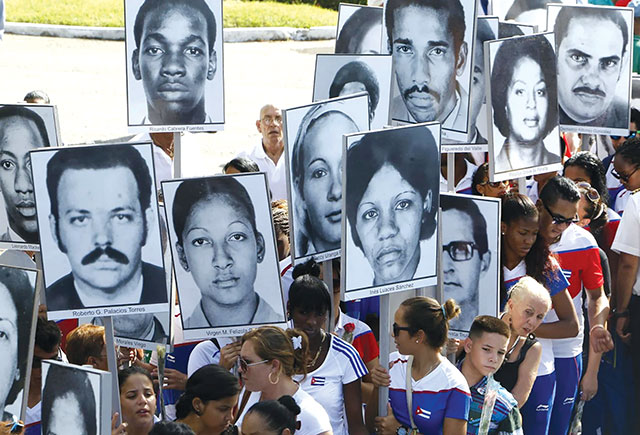
On 40th anniversary of counterrevolutionaries 1976 bombing of Cubana Flight 455, marchers in Havana carry victims pictures. Among those killed by gusano terrorists were the teenage athletes of Cubas national fencing team. (Photo: Ernesto Mastrascusa / European Pressphoto Agency)
In July of this year, one after another, big-business media empires launched new torrents of denunciation against Cuba. For over six decades, the Yankee imperialists have tried to starve the rebel island into submission, seeking revenge against the 1959 Cuban Revolution that threw out the dictatorship of Fulgencio Batista and his U.S. overlords.1 Under their current administration of Joe Biden & Co., the deadly U.S. blockade (embargo) against Cuba maintains heightened measures ramped up when Donald Trump was in the White House. Many here were blurry on the background when the U.S. governments Voice of America blared Biden Condemns Cuba for Crackdown on Freedom Protesters, referring to coordinated protests that occurred in various parts of the island on July 11.
Mainstream media followed and Bernie Sanders Backs Cuban Protests, headlined the London Independent (11 July). Alexandria Ocasio-Cortez issued a statement on Congress of the United States letterhead echoing the State Department spin on the protests. We stand in solidarity as Cubans rise up and protest for their rights as never before, wrote AOC, calling to condemn the anti-democratic actions of the Cuban government.2 Much of the self-proclaimed left took a similar tack.
In sharp contrast, we Trotskyist defenders of the Cuban Revolution told the truth about the events. What was really going on?
While fueled by desperation over food shortages, lack of medicine and blackouts that have beset the island in the wake of the coronavirus pandemic, the marches were instigated, manipulated and exploited by forces seeking to overthrow the Cuban Revolution. With its exemplary public health system, Cuba has been able to contain the virus far better than almost anywhere else on the planet outside of China. Yet U.S. rulers are seeking to capitalize on the economic toll of the pandemic, and weariness from 60 years of imperialist blockade. In this difficult situation, the first duty of revolutionary communists, in Cuba and worldwide, is to actively combat the forces of capitalist counterrevolution.3
Attempting to paint a picture of a revolution on its last legs, U.S. media obscured or smeared the pro-Revolution demonstrations that drew tens of thousands in Havana and many in other parts of the island. After Fidel Castros 26 of July Movement defeated Batistas notoriously corrupt U.S.-equipped army and police torture squads, the victorious Revolution raised the standard of living for millions. This included rural and urban poor and working-class people, notably the Afro-Cuban population whose labor had created incalculable wealth, first for the owners of slave plantations and then for U.S.-owned sugar companies, yet had been condemned to destitution and Jim Crow-style discrimination under the old, U.S.-installed regime.
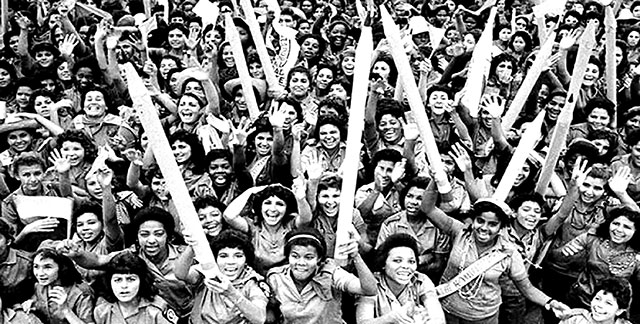
21 December 1961: Literacy teachers holding huge pencils in victory march of Cubas historic campaign to eliminate illiteracy. Where U.S.-backed Batista regime had mired Cuba in poverty and illiteracy, the Revolution enrolled volunteers, largely young women and teenagers, to spend a year in the countryside teaching population to read and write. Free universal education, medical care are among key gains of anti-capitalist revolution.
(Photo: Liborio Noval)
Already in its first two years, the Revolution had eliminated illiteracy, distributed land to hundreds of thousands of poor peasants, radically slashed rents and defeated the CIA-organized mercenary army of gusanos (counterrevolutionary worms) at the Bay of Pigs. Cuba went on to build a world-renowned system of medical care and biomedical innovation, capable of developing five COVID vaccines despite the U.S. embargo. None of that would have been possible if Cuba had remained subjugated to the capitalist system of production for profit. Here in the U.S., one of the most basic tasks of revolutionary-minded youth and workers is to defend Cuba and its revolution against our own imperialist rulers, who are the biggest enemies of the oppressed around the world and here at home.
Only the truth is revolutionary. Yet some left groups pretend it helps Cuba if they deny reality and claim its already socialist, echoing Joseph Stalins anti-Marxist dogma that you can build socialism in one country. (Among them: the pro-Biden, ultra-reformist Communist Party USA; also Workers World, Party for Socialism and Liberation, and others.)
We Trotskyists explain that difficulties facing the Cuban workers state are further complicated by the fact that it is bureaucratically deformed by the privileged nationalist bureaucracy that sits atop the collectivized economy. Increasingly, it has been promoting pro-capitalist reforms that will foster the growth of capitalist inroads and pro-capitalist forces. Intransigently defending the Cuban Revolution against imperialism and internal counterrevolution, Trotskyists call to replace the stultifying bureaucracy with the proletarian democracy of workers councils, that is, a proletarian political revolution to defend and extend the historic gains won in Cuba, through international socialist revolution.
Revolution highly recommends that readers dig deeper into these issues and check out The Truth About Cuba Protests (July 2021) and accompanying items on internationalist.org.
In the Belly of the Beast
Recent events make this a good time to bring to our readers attention an exciting film called Wasp Network (2019). Its a dramatization of the history of the Cuban counterintelligence operation of the same name (La Red Avispa), by French director Olivier Assayas. Starring Gael García Bernal, Penelope Cruz and others, the movie available on Netflix is based on the book The Last Soldiers of the Cold War: The Story of the Cuban Five (2015) by Brazilian author Fernando Morais. It is clear from the outset that Assayas is no communist. But Wasp Network vividly portrays the basic fact that a Miami-based gusano mob has long served as shock troops for U.S.-sponsored capitalist counterrevolution in Cuba. (Uncoincidentally, key players instigating Julys counterrevolutionary protests operate out of Miami.)
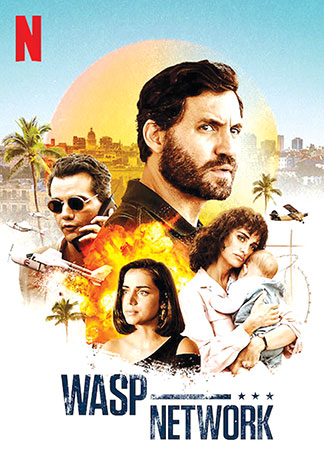 Wasp Network
(2019), available on Netflix, tells the story of the Cuban
Five.
Wasp Network
(2019), available on Netflix, tells the story of the Cuban
Five.Wasp Network tells the story of the five Cuban spies who in the 1990s risked their lives to thwart terrorist attacks against Cuba orchestrated by figures such as Luis Posada Carriles, a former CIA operative and longtime would-be assassin of Fidel Castro. In 1997, he was the architect of hotel bombings that sought to cripple Cubas tourist industry. Together with another notorious counterrevolutionary terrorist, Orlando Bosch, Posada Carriles was behind the 6 October 1976 bombing of Cubana airlines Flight 455, in which all 73 passengers were killed, including 24 teenage members of the national fencing team.
First among the films five protagonists is René González, who leaves Cuba in December of 1990 under the guise of defecting to the U.S. His skills as a pilot allow him to infiltrate the counterrevolutionary Hermanos al Rescate (Brothers to the Rescue) outfit headed by José Basulto. In the 80s Basulto, trained and employed by the CIA, flew supplies to the Contras it organized and armed to wage a counterrevolutionary proxy war against the revolution that overthrew the U.S.-installed dynasty of Anastasio Somoza Nicaraguas counterpart to Batista.
The ostensible purpose of Hermanos al Rescate was to aid balseros (raft people) taking to the Florida Straits, as conditions brought about by the U.S. blockade were worsened after capitalist counterrevolution in the former USSR deprived Cuba of Soviet aid. But what Basulto and his bandit band aimed at was bringing bloody counterrevolution to Cuba. In the film Basulto, over lunch with René González, remarks: The collapse of the Soviet Union has raised peoples hopes, and without Russian money, [Castro] wont last long. His end game? When the regime collapses, theyll have to return the refineries, banks, factories. And casinos!
José Basultos father was in fact an executive with the Punta Alegre Sugar Company, which was expropriated after the Revolution. Such capitalist property, and the wealth it squeezed out of Cubas poor, was what he and his ilk longed to rescue. He was no starving refugee, and the same goes for his associates in the ultra-rightist Miami exile milieu, such as the late Jorge Mas Canosa of the Cuban American National Foundation. Such offspring of the Cuban bourgeoisie were welcomed with open arms by the CIA for the express purpose of returning Cuba to imperialist domination. In the film, Basulto eventually tells René bluntly: Were not just a humanitarian [sic] organization, were a militant organization. Then and now, humanitarian intervention is code for imperialist subjugation.
No amount of brutality, criminality and dirty tricks were off-limits for the agents of counterrevolution. Wasp Network depicts the drug trafficking which served as a major source of funding for U.S.-backed anti-communist terror groups and death squads in Central America during the 1980s and 90s. And going back decades, all manner of plots were made to kill Fidel Castro in the wake of the Cuban Revolution, with many of them detailed in the 2006 documentary 638 Ways to Kill Castro. A notable Pentagon-proposed terror scheme was Operation Bounty in 1962, which would have created a system of financial rewards for Cubans for killing or delivering alive known Communists, with the reward paid upon presentation of conclusive proof of death and the deceaseds party membership card.4
Wasp Network vividly shows that the Avispa group and colleagues back in Cuba worked in earnest to stop deadly dangerous threats. The film also avoids presenting the Wasp Network as Bond-style suaves fueled by martinis and love affairs. They lived their lives within the U.S. working class and suffered conditions faced by millions of immigrant workers. In the U.S., Olga Salanueva, a trained industrial engineer married to René González, had to work first in a care home and then at a telemarketing firm. Like millions in this country, she lacked health insurance. Her second child, Ivette, was born with her umbilical cord coiled twice around her neck due to the hospitals unwillingness to perform a C-section and had to be rushed into intensive care due to oxygen deprivation. So much for the land of opportunity.
One of the films dramatic scenes is the 24 February 1996 shootdown of two Hermanos al Rescate planes by Cuban Air Force pilots. After a series of provocative violations of Cuban airspace, Basultos gang had once again moved past the 12-mile line (the limits of Cubas territorial sea). Warned by the Cuban military to turn back, they ignored this and were shot down. Wasp Network depicts Basulto as being baffled and shocked by the course of the events. In reality, he knew damn well what he was doing, staging dangerous provocations (which created a cause célèbre for counterrevolutionary agitation), and reportedly laughed about it. Revolutionaries defended the shootdown of the Hermanos planes as part of Cubas basic right to self-defense.5
The films final scenes portray the FBIs September 1998 dismantling of the courageous Avispa operation, as it arrested Cuban immigrants in September 1998 on an array of 26 different charges, ranging from being unregistered agents of a foreign government to conspiracy to commit espionage and, to escalate the stakes, even conspiracy to commit murder. Apparently their crime was not announcing to the imperialist authorities their work in defense of their country against deadly threats and attacks long promoted by those same imperialists. (However, after intelligence collected by the Wasp Network reached Havana, much of it was actually shared with the U.S. government.)
The Cuban Five and Defense of Cuba Today
Known as the Cuban Five internationally and the Five Heroes in Cuba, René González, Gerardo Hernández, Ramón Labaniño, Fernando González and Antonio Guerrero experienced firsthand the brutality of the U.S. criminal justice system, languishing in the dungeons of the capitalist state for over a decade. This included long stints in solitary confinement. The 2001 trial of the Five was held in Miami, the heart of gusano terrorism, in the wake of a hysterical rightist press campaign against Fidel Castro and the Cuban Revolution.
The jury foreman openly proclaimed his hatred for the Cuban leader, and the defendants were declared guilty on all counts by a jury that did not ask a single question. This, combined with arbitrary detention, limitations on lawyer visitation and separation from one another, made even the semblance of a fair trial impossible. When a three-judge panel of the 11th Circuit Court of Appeals unanimously threw out the convictions and ordered a new trial on the grounds of the location and prejudicial publicity, the U.S. government appealed the ruling and the convictions were upheld.
René González was the first of the Five to be freed, followed by Fernando González in February 2014.6 Those remaining were released in December of that year as part of a prisoner exchange which saw Cuba give up Rolando Sarraff Trujillo (an imperialist double agent who helped engineer the Fives arrest). On the U.S. side, this was part of the short-lived Cuban thaw undertaken by the Obama administration, which sought to further the long-standing U.S. objective of capitalist restoration through a more soft power approach including pressing to open Cubas economy. (As we have noted, inequalities fostered by some market reforms that have been promulgated by the Cuban government were part of the background to the July 11 counterrevolutionary protests.)
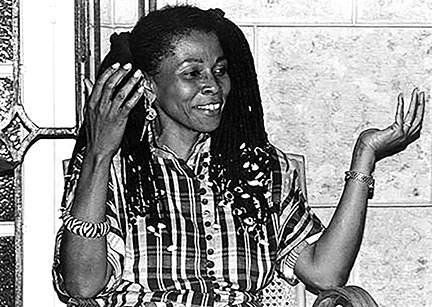 Assata Shakur in Cuba.
Assata Shakur in Cuba.For decades, the U.S. has sought to extradite Assata Shakur, the former Black Panther (and aunt of rapper Tupac Shakur), who was framed up on murder charges and incarcerated by the racist capitalist state. In 1979, Shakur managed to escape from prison and by 1984 had made it to Cuba, where she was granted political asylum. There, she has authored the widely read Assata: An Autobiography (1987), helped publicize the truth about the FBIs murderous COINTELPRO program, given interviews about life in Cuba and inspired many with her courage and resilience.7 In the U.S., politicians and administrations both Democratic and Republican have pursued Assatas extradition. (Among them: Bernie Sanders, who in 1998 was one of the 205 Republicans and 165 Democrats who in a vote of both chambers of Congress voted to demand her extradition to the U.S. as a convicted felon.) Today, Assata Shakur remains on the FBIs Most Wanted list, with a million-dollar bounty on her head, showing the truth of her observation that, in the eyes of racist U.S. imperialism, she is a modern-day escaped slave.
Wasp Network achieves something important: breaking through the imperialist propaganda machine, it tells the truth about counterrevolutionary provocations against Cuba and the Red Avispas heroic efforts to thwart them. Unfortunately, the intimate relationship between the U.S. State Department and the Miami clot of gangsters and terrorists is not depicted in the film. Those who dont know the long history of U.S. provocations against the Cuban deformed workers state could walk away from Wasp Network with the impression that Carriles, Bosch, Basulto and their ilk were just independent hotheads who developed an appetite for intrigue and violence, somehow passively tolerated by Washington. The truth is the professionals of counterrevolution were creatures cultivated and trained by the CIA, used in U.S. imperialisms clandestine operations across Latin America and beyond.
Despite its shortcomings, Wasp Network shows a slice of what U.S. imperialism really means when its mouthpieces spout propaganda about freedom; and the brutality that exiled capitalists and henchmen are prepared to employ in their quest to restore capitalism on the island.
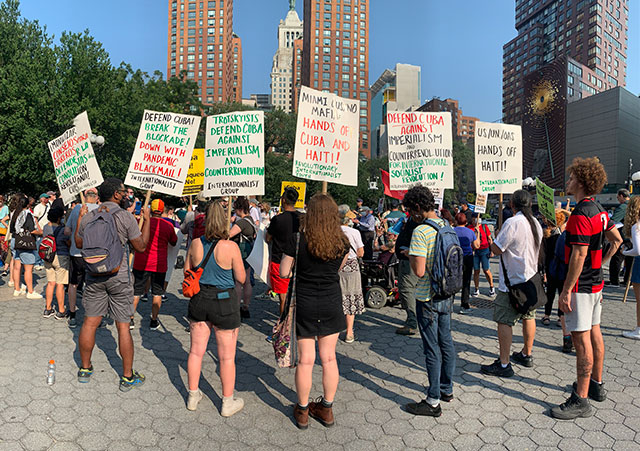
CUNY Internationalist Clubs and Internationalist Group at July 15 Union Square demonstration in defense of the Cuban Revolution. (Internationalist photo)
In the wake of last summers counterrevolutionary protests, René González of the Cuban Five was interviewed in a podcast published on the Cubadebate website (28 July). He noted that unleashing hatred against Cuba continues to be a business in Miami and Washington, seeking to exploit real difficulties and problems facing the Revolution. González is asked why this antagonism toward Cuba is unending from one U.S. administration to the next; it always seems like déja vu all over again, notes the interviewer. González responds: Cuba continues to be a thorn in the flesh of Yankee imperialisms arrogance, whether Democrats or Republicans are in office, whether or not one [politician] is more intelligent than another.
Imperialism is the hand that rocks the cradle of counterrevolution, the interviewer agrees. That includes those who organize from south Florida, seeking nothing less than the freedom to drown Cuba in poverty and enrich themselves in the process. Wasp Network gives us an important glimpse of what its all about. ■
- 1. In addition to companies such as United Fruit, Domino Sugar, Texaco, plus U.S. imperialisms Murder Inc. of the CIA, State Department, etc., this included the Mafia figures who ran much of Havana in partnership with Batista. This is famously depicted in The Godfather Part Two and described in fascinating detail in Havana Nocturne: How the Mob Owned Cuba ... And Then Lost It to the Revolution (2009) by T.J. English.
- 2. Sanders and Ocasio-Cortezs declarations of support for the counterrevolutionary protests did not satisfy right-wing mouthpieces. After fulsomely hailing the U.S.-backed protests, AOCs statement pleaded it is never acceptable for us to use cruelty as a point of leverage against every day people (i.e., measures of leverage should just include those on the Cuban state itself?) while opposing the Biden administrations defense of the embargo.
- 3. The Truth About Cuba Protests: Defend the Revolution Against U.S. Imperalism and Its Frontmen (July 2021). Also see the accompanying articles U.S. Blockade of Cuba: Bring About Hunger, Desperation, Overthrow and Cuba Is Being Accused of Many Things Lets Fact Check Them.
- 4. Martin Garbus, North of Havana: The Untold Story of Dirty Politics, Secret Diplomacy, and the Trial of the Cuban Five (2019).
- 5. See Free the Cuban Five! The Internationalist No. 27, May-June 2008.
- 6. René González was released on parole in 2011, but did not return to Cuba until 2013 and was allowed to stay provided he renounced his U.S. citizenship.
- 7. See The FBIs Covert Program to Destroy the Black Panther Party and Prisoner in Paradise: An Interview with Assata Shakur at assatashakur.org and listen to or read Assata, Guilty of Survival at prisonradio.org by Mumia Abu-Jamal, the former Black Panther and journalist who is Americas foremost class-war prisoner. (Revolution and The Internationalist have run many articles over the years on Mumias case, among them Free Mumia Abu-Jamal Now! in Revolution No. 9, November 2011 and No Execution By COVID Free Mumia Abu-Jamal Now! in The Internationalist No. 62, January-April 2021.)
